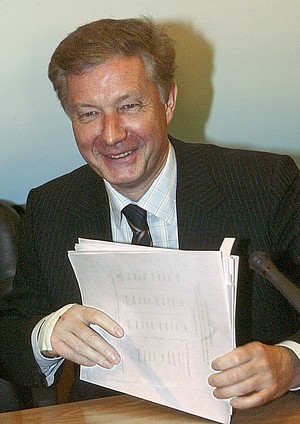
GAZPROM SQUEEZING BELARUS
Publication: Eurasia Daily Monitor Volume: 3 Issue: 68
By:

Addressing an international energy conference on April 4-5 in Moscow, Gazprom Vice-Chairman Alexander Ryazanov threatened to raise the price of gas to Belarus to “at least triple the present level” after December 31, 2006, so as to bring the price for Belarus “in line with European prices that keep rising” (Interfax, April 5). Simultaneously with that energy event, ironically, Moscow hosted a festive conference greeted by President Vladimir Putin on the tenth anniversary of the formation of the Russia-Belarus Union (which exists on paper only).
Gazprom’s warning aims to force Belarus to speed up the handover of the national gas transport and distribution company, Beltransgas, to Gazprom. If that happens, the Russian side would concede a sweetheart price for gas to Belarus, at least temporarily. Any major price increase could drive Belarusian industries to the verge of bankruptcy, potentially setting the stage for takeovers by Russian capital. Gazprom gave Belarus until April 30 to respond with regard to Beltransgas.
The Russian and Belarusian governments had agreed in principle in July 2003 to turn Beltransgas into a parity joint venture. More recently, Moscow seemed to aim for a full takeover. Gazprom estimates the total value of Beltransgas at $700 million, based on Belarusian prices. Official Minsk, however, has recently estimated that Beltransgas is worth at least $5 billion, based on international market prices. The sides have agreed to ask a “neutral” consulting company to appraise Beltransgas, but have not yet found a mutually acceptable appraiser.
Belarus pays $46.68 per 1,000 cubic meters of Russian gas in 2006, under a one-year contract signed on December 27, 2005. This price is the same as in 2004, and the last case of Russian one-sided preferential treatment of any gas-importing country in the CIS. Gazprom is to deliver 21 billion cubic meters of gas to Belarus this year, amply covering the country’s requirements. However, Gazprom pays ridiculously low fees for the transit of its gas to European Union territory via Belarus: only $0.75 per one thousand cubic meters per one hundred kilometers through Beltransgas pipelines, and a mere $0.46 per one thousand cubic meters per one hundred kilometers through the Belarus stretch of the Yamal-Europe pipeline (Interfax, March 31).
On January 27 and March 7, the two governments signed a framework agreement on Belarus’ fuel and energy balance and Russian deliveries from 2006 through 2020, whereby Russia would increase gas deliveries to 26 billion cubic meters annually. This nonbinding agreement of intent, as well as the price for 2007 and thereafter, is linked to the sale of Beltransgas to Gazprom and advancement toward institutionalization of the Union State (Belapan, January 30; Interfax, March 7).
To press its point, Gazprom had reduced gas supplies by 30% during the period of freezing temperatures in January-February of this year. The cuts forced Belarus’ state electricity company to generate electricity using oil fuel, which is much more expensive than gas (Belapan, January 23). Starting in January, a joint working group is discussing options for Belarus to transfer industrial assets to Russian control — apart from Beltransgas — in return for continuation of low-priced gas deliveries.
Gazprom shows interest in acquiring the Hrodna Azot fertilizers factory, the electrical power-generating plant in Belaazyorsk (Brest region), and the Khimvolokno artificial fiber plant. These gas-intensive plants — if re-equipped through Gazprom-financed investments — have the potential to become profitable exporters to EU markets. “Joint use” and expansion of storage capacity for Russian gas in Belarus for export to the EU is also on the working group’s agenda.
In 2005, Gazprom exported approximately 41 billion cubic meters of gas through Belarus, including some 22 billion through the first trunk line of the Yamal-Europe pipeline, and the remainder through Beltransgas. The Yamal-Europe trunk line is supposed to become fully operational in 2006 at its design capacity of 33 billion cubic meters annually, but work on compressor stations lags behind schedule. Belarus last year recognized Gazprom’s ownership of that pipeline on Belarus’ territory and granted Gazprom a long-term lease on the land along the pipeline. However, these steps have only resulted in a short-term reprieve from the Russian side, which seems intent (as in Armenia — see EDM, April 7) to take over some the country’s main economic assets, using Gazprom’s position as a monopoly supplier.
(Interfax, March 31, April 4, 5; see EDM, February 6)




